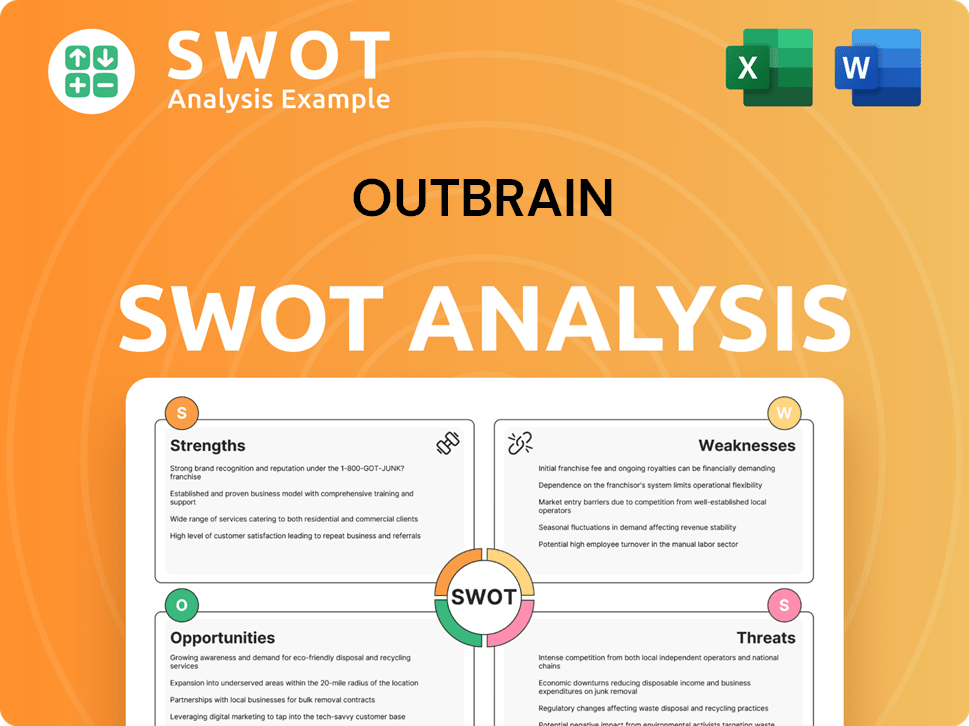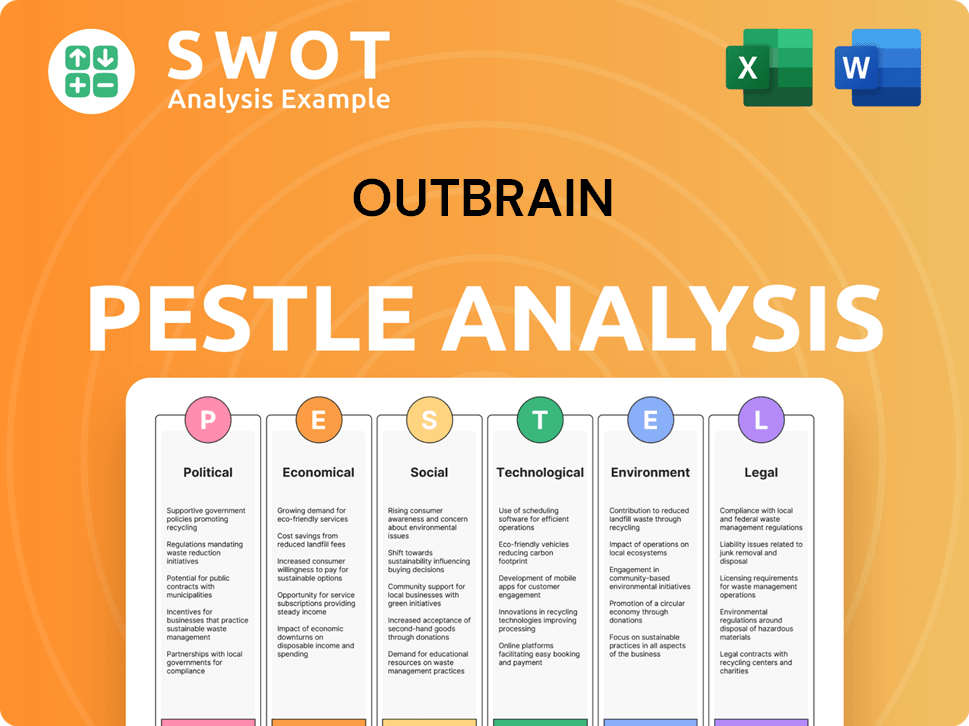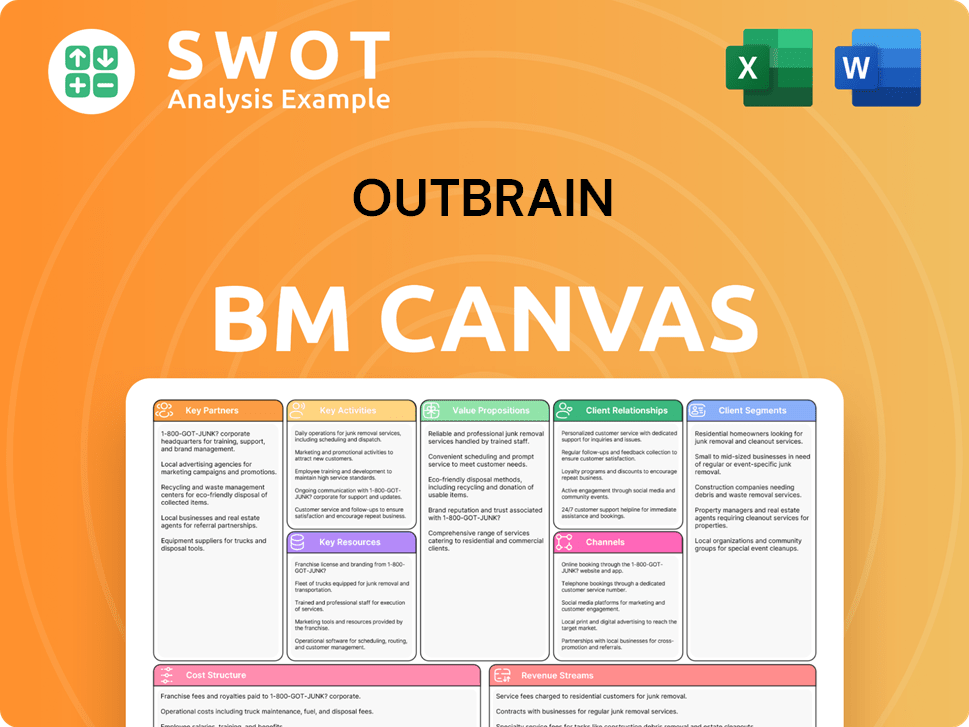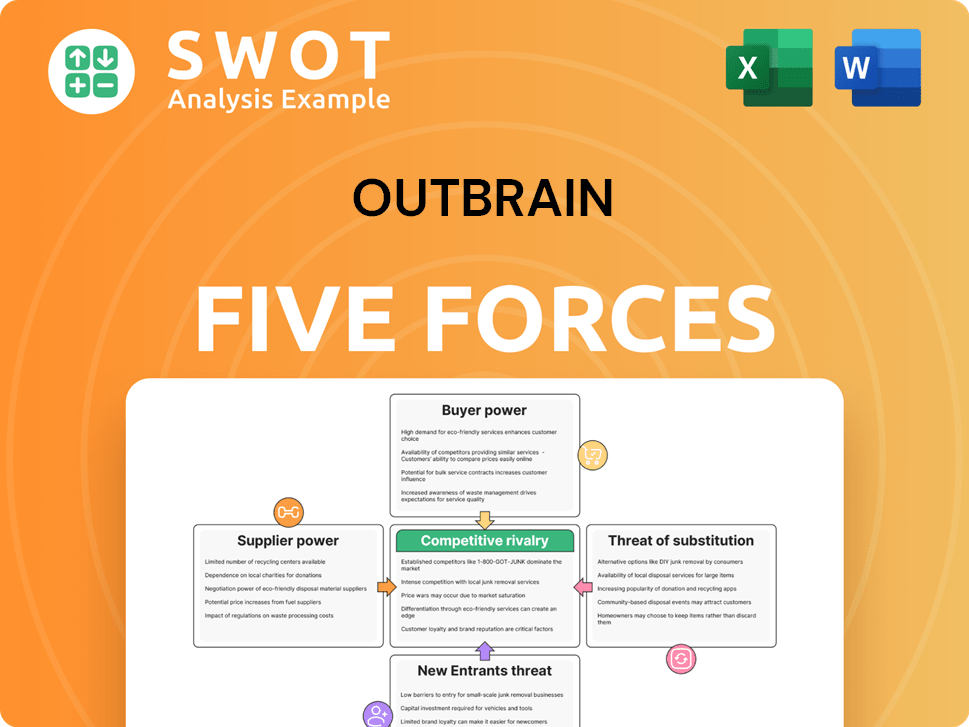Outbrain Bundle
How Does Outbrain Thrive in the Digital Landscape?
Outbrain, a trailblazer in content recommendation, has reshaped how we discover information online. Following its strategic acquisition of Teads, the company, now operating under the Teads brand, has become a dominant force, connecting users with tailored content across a vast network. This evolution is critical for understanding its impact on publishers, advertisers, and the future of the open web.

With over 10,000 publishers and 20,000 advertisers utilizing the Outbrain SWOT Analysis platform, the combined entity is a global powerhouse in online advertising. Understanding the intricacies of Outbrain advertising, from its native advertising formats to its content recommendation engine, is key to appreciating its value proposition. This analysis delves into how Outbrain generates revenue and its competitive advantages within the dynamic world of content discovery, offering insights for both investors and industry professionals.
What Are the Key Operations Driving Outbrain’s Success?
Operating under the Teads brand, Outbrain functions as an omnichannel outcomes platform designed for the open internet. It focuses on delivering full-funnel results for marketers across premium media. The core of its operations revolves around providing personalized content recommendations and advertising solutions, catering to both publishers and advertisers.
Outbrain's value proposition lies in its ability to connect audiences with relevant content and advertisements. For publishers, the platform's content recommendation engine boosts user engagement, extends session times, and enhances the overall user experience. Advertisers benefit from a platform that promotes their content and reaches a wider audience through personalized recommendations on various websites.
The operational processes underpinning Outbrain's offerings are heavily reliant on sophisticated technology, particularly in AI and machine learning. This technology enables the platform to process billions of data events each minute. This rapid processing allows Outbrain to effectively match audiences with personalized content and ads, optimizing for both user engagement and advertiser return on investment (ROI). The company's supply chain and distribution networks are built on extensive global partnerships, collaborating with over 10,000 publishers and 20,000 advertisers.
Outbrain's core technology leverages AI and machine learning to analyze user behavior and content performance. This analysis drives the content recommendation engine, which suggests relevant articles and videos. The platform uses this data to personalize ad delivery and improve campaign effectiveness for advertisers.
Publishers use Outbrain to increase user engagement and generate revenue through content recommendations. By displaying relevant content, Outbrain helps publishers keep users on their sites longer. This increased engagement translates into higher ad revenue and a better user experience.
Advertisers utilize Outbrain to promote their content and reach a wider audience through native advertising. The platform's targeting capabilities allow advertisers to display personalized recommendations on various websites. This approach increases brand visibility and drives traffic to advertiser content.
The acquisition of Teads has enhanced Outbrain's capabilities, creating a 'brandformance' platform. This integration combines Outbrain's performance solutions with Teads' expertise in brand advertising. The platform delivers elevated outcomes across branding and performance, particularly in curated, quality media environments, including Connected TV (CTV).
Outbrain distinguishes itself through its proprietary AI technology and an extensive global network of exclusive partnerships. This network enables targeted campaign distribution at a massive scale, reaching a broad audience. The platform's ability to process vast amounts of data in real-time is a key differentiator.
- Proprietary AI and machine learning algorithms for content recommendations.
- Extensive global network of premium publishers.
- Integration with Teads for enhanced brand advertising capabilities.
- Focus on delivering full-funnel results for marketers.
Outbrain SWOT Analysis
- Complete SWOT Breakdown
- Fully Customizable
- Editable in Excel & Word
- Professional Formatting
- Investor-Ready Format

How Does Outbrain Make Money?
The primary revenue stream for Outbrain is generated through a performance-based advertising model, specifically a pay-per-click (PPC) system. Advertisers pay for each click on their recommended content, aligning Outbrain's interests with those of its clients by focusing on engagement and measurable results. In 2024, the combined advertising spend of Outbrain and Teads reached approximately $1.7 billion.
Outbrain's financial performance in 2024 showed a revenue of $889.9 million, a 5% decrease from the previous year's $935.8 million. However, the company demonstrated improved profitability, with a gross profit of $192.1 million, up 4% from $184.8 million in 2023. The gross margin increased to 21.6% in 2024 from 19.7% in 2023. The ex-TAC (excluding traffic acquisition costs) gross profit for 2024 was $236.1 million, a 4% increase from $227.4 million the prior year.
The first quarter of 2025, which included the acquisition of Teads, showed a substantial increase in revenue. Revenue reached $286.4 million, a 32% increase compared to $217.0 million in the same period the previous year. This growth was primarily attributed to the acquisition. The gross profit for Q1 2025 was $82.7 million, a 99% increase compared to $41.6 million in the prior year period, with the gross margin rising to 28.9% from 19.2%. Ex-TAC gross profit for Q1 2025 was $103.1 million, a 98% increase compared to $52.2 million in the prior year.
Outbrain is expanding beyond traditional content feeds to diversify its revenue streams. This includes generating revenue from supply sources beyond the traditional feed. This strategy is evident in the fact that approximately 30% of revenue in Q4 2024 came from sources outside the traditional feed, up from 26% in Q4 2023. This diversification includes OEMs, apps, and other platforms. The company is also seeing significant growth in connected TV (CTV), with over 100% year-over-year growth in Q1 2025, now representing approximately 5% of total ad spend. Further, the company's Demand-Side Platform (DSP) continues to grow, with a 45% increase in advertiser spend in FY 2024, driven by superior performance across native, display, and video formats. For more insights into Outbrain's overall strategy, consider reading about the Growth Strategy of Outbrain.
- Outbrain platform utilizes a pay-per-click (PPC) model for Outbrain advertising.
- Revenue diversification includes sources beyond traditional content feeds.
- Connected TV (CTV) advertising is experiencing significant growth.
- The DSP (Demand-Side Platform) is driving increased advertiser spend.
Outbrain PESTLE Analysis
- Covers All 6 PESTLE Categories
- No Research Needed – Save Hours of Work
- Built by Experts, Trusted by Consultants
- Instant Download, Ready to Use
- 100% Editable, Fully Customizable

Which Strategic Decisions Have Shaped Outbrain’s Business Model?
A significant milestone for Outbrain was the acquisition of Teads, finalized in February 2025. This strategic move, valued at approximately $900 million, brought together two major players in the open internet advertising sector. The combined entity now operates under the Teads brand, aiming to capitalize on the strengths of both companies.
The merger is expected to yield substantial financial benefits. By 2026, the integration is projected to generate annual synergies ranging from $65 million to $75 million. In 2025 alone, cost synergies are anticipated to reach around $40 million, reflecting the efficiency gains from the consolidation.
Outbrain has faced challenges, including market saturation and reliance on publisher partnerships in the competitive content recommendation landscape. The company has responded by focusing on innovation and adapting to evolving market trends. The launch of 'Moments' in Q3 2024, a vertical video experience, demonstrates this commitment, with the feature now live on over 70 publishers, including Axel Springer and Fox News.
The acquisition of Teads in February 2025 was a pivotal moment. This merger, valued at around $900 million, combined two industry leaders. The move is expected to generate significant cost savings and revenue synergies.
Outbrain has focused on innovation, such as the 'Moments' vertical video experience. The company is also adapting to new advertising trends, including the growth in Connected TV (CTV) advertising. The company is adapting to new trends, such as the growth in Connected TV (CTV) advertising, which saw over 100% year-over-year growth in Q1 2025.
Outbrain's advantages include its established brand and advanced technology. The company has a vast global network of premium digital media partners. The acquisition of Teads enhances this edge, creating a 'brandformance' platform. For more details, see the Marketing Strategy of Outbrain.
Outbrain is positioning itself well for a post-cookie advertising environment. The company focuses on delivering relevant experiences based on context and interest. This approach is crucial for maintaining effectiveness in the evolving digital advertising landscape.
Outbrain's competitive edge stems from its established brand, advanced technology, and extensive network of media partners. The acquisition of Teads further strengthens its position by combining performance capabilities with brand advertising expertise, forming a 'brandformance' platform. The company's focus on contextual relevance and adapting to emerging trends like CTV advertising positions it well for future growth.
- Established brand as a pioneer in content discovery.
- Advanced technology, including sophisticated algorithms and machine learning for personalized recommendations.
- Extensive global network of premium digital media owners.
- Strategic acquisition of Teads, enhancing its 'brandformance' capabilities.
- Adaptation to new trends, such as CTV advertising, which saw over 100% year-over-year growth in Q1 2025.
Outbrain Business Model Canvas
- Complete 9-Block Business Model Canvas
- Effortlessly Communicate Your Business Strategy
- Investor-Ready BMC Format
- 100% Editable and Customizable
- Clear and Structured Layout

How Is Outbrain Positioning Itself for Continued Success?
As a key player in content discovery, now operating as Teads, the company holds a strong position in the native advertising sector. In the broader advertising market, it holds a market share of 6.98%, competing with major players. The company connects advertisers with audiences across a global network of premium digital media properties.
However, the company faces several risks. These include revenue declines, integration challenges from recent acquisitions, and intense competition in the digital advertising space. Macroeconomic factors and regulatory changes also pose potential threats to the company's operations.
The company has a notable presence in native advertising. It competes with major players like Google Ads. The company serves over 35,961 companies globally for advertising in 2025, with 62.43% of these customers located in the United States.
Key risks include revenue decline, integration issues, and competitive pressures. Revenue for the full year 2024 decreased by 5% compared to 2023. The company reported a net loss of $54.8 million in Q1 2025, largely due to acquisition-related and restructuring costs.
The company is optimistic about its future, focusing on integrating Teads and expanding its 'Moments' vertical video offering. For the full year 2025, the company anticipates an Adjusted EBITDA of at least $180 million. The company expects a return to pro forma growth in the second half of the year.
The company is integrating Teads, aiming for $65 million to $75 million in annual synergies by 2026. The company is also focused on its 'Moments' vertical video offering, which is gaining traction with over 70 publishers. The company aims to combine branding and performance capabilities.
The company's ability to sustain and expand its ability to make money by leveraging its combined strengths is crucial. The company is adapting to evolving consumer behavior and preferences in the digital advertising landscape. For more insights, check out the Growth Strategy of Outbrain.
- The company's market share in brand management is 19.37%.
- The company is focused on content recommendation and native advertising.
- The company aims to deliver elevated outcomes for brands and media owners.
- Ongoing strategic initiatives include the integration of Teads.
Outbrain Porter's Five Forces Analysis
- Covers All 5 Competitive Forces in Detail
- Structured for Consultants, Students, and Founders
- 100% Editable in Microsoft Word & Excel
- Instant Digital Download – Use Immediately
- Compatible with Mac & PC – Fully Unlocked

Related Blogs
- What are Mission Vision & Core Values of Outbrain Company?
- What is Competitive Landscape of Outbrain Company?
- What is Growth Strategy and Future Prospects of Outbrain Company?
- What is Sales and Marketing Strategy of Outbrain Company?
- What is Brief History of Outbrain Company?
- Who Owns Outbrain Company?
- What is Customer Demographics and Target Market of Outbrain Company?
Disclaimer
All information, articles, and product details provided on this website are for general informational and educational purposes only. We do not claim any ownership over, nor do we intend to infringe upon, any trademarks, copyrights, logos, brand names, or other intellectual property mentioned or depicted on this site. Such intellectual property remains the property of its respective owners, and any references here are made solely for identification or informational purposes, without implying any affiliation, endorsement, or partnership.
We make no representations or warranties, express or implied, regarding the accuracy, completeness, or suitability of any content or products presented. Nothing on this website should be construed as legal, tax, investment, financial, medical, or other professional advice. In addition, no part of this site—including articles or product references—constitutes a solicitation, recommendation, endorsement, advertisement, or offer to buy or sell any securities, franchises, or other financial instruments, particularly in jurisdictions where such activity would be unlawful.
All content is of a general nature and may not address the specific circumstances of any individual or entity. It is not a substitute for professional advice or services. Any actions you take based on the information provided here are strictly at your own risk. You accept full responsibility for any decisions or outcomes arising from your use of this website and agree to release us from any liability in connection with your use of, or reliance upon, the content or products found herein.